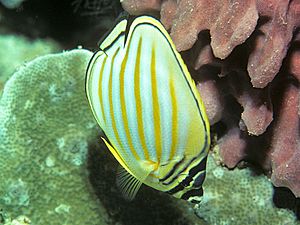Ornate butterflyfish facts for kids
Quick facts for kids Ornate butterflyfish |
|
|---|---|
 |
|
| At Sipadan Island (Malaysia) | |
| Conservation status | |
| Scientific classification | |
| Genus: |
Chaetodon
|
| Species: |
ornatissimus
|
| Synonyms | |
|
|
The ornate butterflyfish (Chaetodon ornatissimus), also known as the clown butterflyfish, is a beautiful species of ray-finned fish. It belongs to the butterflyfish family, called Chaetodontidae.
This fish is closely related to the mailed butterflyfish (C. reticulatus) and the scrawled butterflyfish (C. meyeri). They are part of a group that scientists once called “Citharoedus”. These fish might also be related to the Melon Butterflyfish (C. trifasciatus).
Contents
What Ornate Butterflyfish Look Like
The ornate butterflyfish is easy to spot because of its unique colors. Its body is mostly white with bright orange or orange-brown stripes. These stripes go across its body at an angle.
Its head has two black stripes with yellow edges. One stripe goes over its eyes, and the other is on its snout. The tail also has two black stripes. These colors and patterns help the fish hide from predators.
Ornate butterflyfish usually grow to be about 13 to 18 centimeters long. Most adult pairs are very similar in size.
How Ornate Butterflyfish Behave
Adult ornate butterflyfish usually live in pairs. They claim their own special areas in clear water lagoons and coral reefs. These areas are rich in coral, which they need to survive. Their territories can be quite large, from about 100 to 1400 square meters.
Young ornate butterflyfish, called juveniles, live alone. They are often shy and hide among the branches of corals for safety. Once they grow up and are ready to have babies, they find a partner and form a pair. It's rare to see an adult ornate butterflyfish without a mate. These pairs also have a "home range" where they usually stay.
Reproduction and Life Cycle
Ornate butterflyfish are known for being monogamous, meaning they have one partner. Many of them even mate for life! They are coral reef fish that form strong pairs.
The time when they lay eggs, called spawning, changes depending on where they live. In tropical areas, spawning happens most often in winter and early spring. In cooler, temperate areas, it happens in midsummer. Spawning usually takes place at dusk. The eggs are released into the water and fertilized there.
Where Ornate Butterflyfish Live
The ornate butterflyfish lives in the warm, tropical waters of the Indo-Pacific region. You can find them from Sri Lanka all the way to Hawaii and the Marquesas Islands. They also live as far north as Southern Japan and south to Lord Howe Island.
These fish live in the ocean, close to shore, in tropical areas. They are usually found around coral reefs. They prefer depths between 1 and 36 meters. This region is home to over three-quarters of all fish species in the world.
Threats to Their Home
Like many other creatures living on coral reefs, ornate butterflyfish face many dangers to their homes. These dangers come from both nature and human activities.
Natural events like big tropical storms, very hot or cold temperatures, and outbreaks of crown-of-thorns sea stars can harm coral reefs. Sadly, these natural events are happening more often.
Human activities also cause problems for coral reefs. These include too much fishing, pollution, and building along the coast. All of these things can destroy corals. More than 30% of the world's coral reefs have already been damaged. Experts believe that by 2030, over 60% of coral reefs could be lost.
When coral reefs are damaged, it hurts the fish that live there, especially butterflyfish. Studies have shown that when corals disappear, the number of butterflyfish goes down. Some groups of butterflyfish have even disappeared completely from certain areas. This is often because they can't find enough food.
Another problem caused by humans is when coral reefs change from being full of corals to being covered in seaweed. Coral reefs provide homes and food for butterflyfish. But butterflyfish avoid corals that are touching seaweed.
When people catch too many plant-eating fish or when too many nutrients get into the water (pollution), it helps seaweed grow. More seaweed means less space for new corals to grow and for young fish to settle.
What Ornate Butterflyfish Eat
Ornate butterflyfish eat only live coral polyps and other tiny organisms. They are known to eat ten different kinds of coral. This is a wider variety than most other coral-eating butterflyfish.
Other butterflyfish that mainly eat coral include the blacktail butterflyfish, eastern triangle butterflyfish, bluelashed butterflyfish, oval butterflyfish, scrawled butterflyfish, and melon butterflyfish.
Ornate butterflyfish have very fine, hair-like teeth. These teeth help them pick out tiny organisms that most other fish can't reach. They mostly eat coral polyps, and the tentacles of feather dusters and Christmas-tree worms.
Since these food sources can quickly hide in their shells, butterflyfish need to be very good at hovering still. They also need to dart quickly over short distances to catch their food before it disappears. Ornate butterflyfish use their pectoral fins like oars to stop, speed up, turn, and even swim backward to do this.
Why Ornate Butterflyfish Are Important
Ornate butterflyfish are very popular with divers and people who keep aquariums. However, it's almost impossible to keep them alive in a home aquarium. This is because they only eat live coral, which is very hard to provide in captivity.
See also
 In Spanish: Pez mariposa adornado para niños
In Spanish: Pez mariposa adornado para niños


